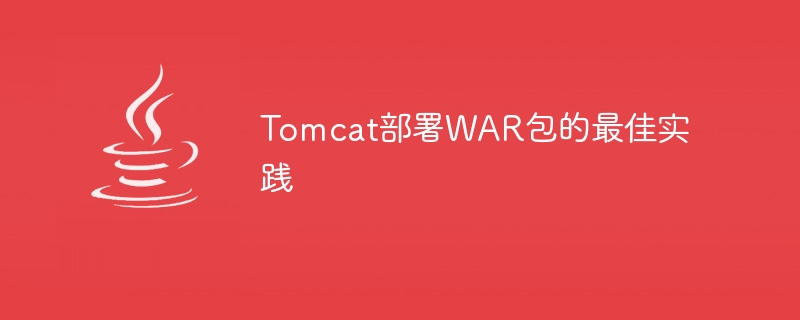

Best practices for Tomcat deployment of WAR packages, specific code examples are required
Tomcat is a widely used open source Java Servlet container for deploying and managing Java Web app. Among them, WAR (Web Application Archive) package is a common web application packaging format, with the extension .war. In this article, we will explore the best practices for deploying WAR packages on Tomcat and provide relevant code examples.
<?xml version="1.0" encoding="UTF-8"?>
<web-app xmlns="http://java.sun.com/xml/ns/j2ee" xmlns:xsi="http://www.w3.org/2001/XMLSchema-instance" xsi:schemaLocation="http://java.sun.com/xml/ns/j2ee http://java.sun.com/xml/ns/j2ee/web-app_3_0.xsd" version="3.0">
<!-- 配置Servlet -->
<servlet>
<servlet-name>MyServlet</servlet-name>
<servlet-class>com.example.MyServlet</servlet-class>
</servlet>
<!-- 配置Servlet映射 -->
<servlet-mapping>
<servlet-name>MyServlet</servlet-name>
<url-pattern>/myservlet</url-pattern>
</servlet-mapping>
</web-app>In the above example, we defined a Servlet named MyServlet and mapped it to the "/myservlet" path.
Find the server.xml file, usually located in the conf directory of Tomcat. Edit the file and add the following code between the
<Context docBase="webapps/myapp" path="/myapp" reloadable="true"></Context>
Please note that "webapps/myapp" here is the path relative to Tomcat's webapps directory, and "/myapp" is The context path of the web application.
startup.bat
After Tomcat starts, open the web browser and enter "http://localhost:8080/myapp/myservlet ", if everything is configured correctly, you should be able to see the output of MyServlet.
So far, we have completed the best practice for deploying WAR packages on Tomcat.
Summary:
This article introduces the best practices for deploying WAR packages on Tomcat and provides specific code examples. By following these steps, you can easily deploy and manage Java web applications. Hope this article helps you!
The above is the detailed content of Best practices for Tomcat WAR package deployment. For more information, please follow other related articles on the PHP Chinese website!
 How to configure Tomcat environment variables
How to configure Tomcat environment variables
 How to integrate idea with Tomcat
How to integrate idea with Tomcat
 How to view Tomcat source code
How to view Tomcat source code
 What are the common tomcat vulnerabilities?
What are the common tomcat vulnerabilities?
 How to solve garbled tomcat logs
How to solve garbled tomcat logs
 What are the differences between weblogic and tomcat
What are the differences between weblogic and tomcat
 What are the differences between tomcat and nginx
What are the differences between tomcat and nginx
 How to solve tomcat startup crash
How to solve tomcat startup crash




